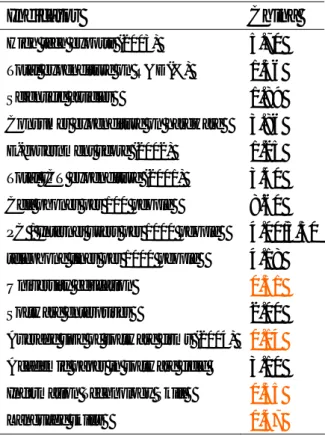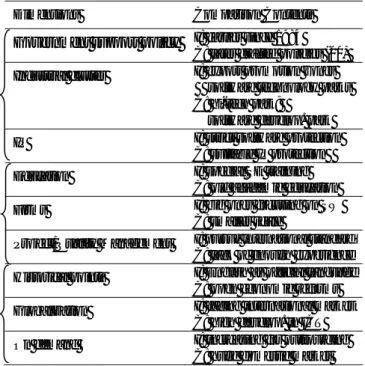JAIST Repository
https://dspace.jaist.ac.jp/
Title
Who will be the Frontier in Next Software Outsourcing? : A comparative analysis between Indian and China focusing on their institutional systems(English Session)
Author(s) 趙, 偉琳; 渡辺, 千仭
Citation 年次学術大会講演要旨集, 22: 169-172
Issue Date 2007-10-27
Type Conference Paper
Text version publisher
URL http://hdl.handle.net/10119/7236
Rights
本著作物は研究・技術計画学会の許可のもとに掲載す るものです。This material is posted here with permission of the Japan Society for Science Policy and Research Management.
1E11
Who will be the Frontier in Next Software Outsourcing?
- A comparative analysis between Indian and China focusing on their institutional systems
○趙偉琳,渡辺千仭(東京工業大学)
1. Introduction
1.1 BackgroundIn recent years, outsourcing has been the core business mode with new significance in the software development. It is noted that developing software in geographically distributed locations is the biggest characteristic of software industry. This has stimulated the development of outsourcing. While only 20 percent had outsourced in the development of ICT functions until 1996, that number had grown to over 55 percent during the period of 1996-2000 and virtually increased to 100 percent today according to a report from DiamondCluster. Thus, outsourcing has grown up to be an established management practice.
Outsourcing decisions have simultaneously been shifting from those based solely on cost savings to those based on how they can enable the firms to meet its growth and profit objectives by satisfying customers’ new requirements to functionality development and solution oriented demand. Consequently, providers of outsourcing services have realized that it is their best option to strive not to price differentiation but to build much better infrastructure, construct more sophisticated technical skills, educate human resources and strengthen communication environments to be more competitive.
With its booming development and inevitable megatrend, the huge market for outsourcing induces
that many countries or entrepreneurs are seeking to capture a share of this enormous market by providing qualified software development resources. India is a famous outsourcing service provider in software development and its achievement has been recognized all over the world. China has also been making conspicuous progress in promoting the development of software industry since the middle of the 1990s and is endeavoring to grow to be the most competitive provider in this market. Will there be a serious competition in the outsourcing market between the two countries?
1.2 Objectives
With data comparisons and empirical analyses based on institutional systems, this paper attempted to give some implications and suggestions for the sustainable development of software industry in both countries since it is the origin of competitive advantages for outsourcing. To learn from each other must be helpful and beneficial.
2. Data Comparisons
2.1 Major indicatorsIt is said that China has left India behind in terms of almost all economic and technological indicators, yet China has failed to catch up with India in software industry. While China is considered an up-and-coming destination for software outsourcing, its threat to India is still some way off. Since it is impossible to compare of all the statistical data
between India and China, some major indicators here are selected to be representatives for comparisons.
Table 1 Major indicators related to software industry(2005)
Indicator China
High tech exports (2003)5.70
Total expenditure on R&D(%)
1.56
Scientific articles1.89
Consumer expenditure on hardware3.86
E-government score (2002)1.25
Total ICT expenditure (2001)3.40
Cell phones per 100 people8.60
PC / Internet users per 1000 people4.00/3.50
telephone lines per 1000 people4.18
University education0.51
Software enterprises
2.00
Average size of software firms (2004)0.14
Academic paper in software field
3.10
Information Technology Skill0.55
Language skills
0.47
a
India as Index = 1.
Table 1 was summarized according to the statistical data from IMD world competitiveness yearbook. It is easier to point out China’s advantage over India in indicators like R&D level, academic research level and ICT utilization, which definitely have relationship with the development of software industry. However, in indicators directly related to software industry, India shows its power well. Good university education which is evaluated as whether it meets the needs of a competitive economy guarantees the talent resources. Large scale software firms, readily available IT skill and good language skills meeting the needs of customers hold the key for the success of Indian software industry and outsourcing services.
2.2 Software exports
In addition to the major indicators related to
software industry, data of industry itself should be more persuasive. India, famous for its excellent outsourcing service with a long history in software development, has left China behind. Fig. 1 tells the difference clearly between India and China.
Fig.1. Software Exports in India and China (US $ 0.1 Billion).
Comparing with China’s software exports from 1999, Indian software industry has developed over two decades and kept the increase until now. Though the gap between the two’s increase rates has been decreasing, India, with its powerful starting base, still remains the absolute advantage. According to a report from Nasscom, The Indian IT-ITES (IT enabled service) sector (including the domestic and exports segments) is expected to exceed USD 47.8 billion in annual revenue in 2007 fiscal year with an increase of nearly 28 percent. The contribution to GDP is estimated to be 5.4% up from 4.8% last year. Service and software exports remain the mainstay of the sector contributing USD 31.3 billion. From the data, it is no doubt that India is still the king of outsourcing now. It seems to be a long way for China to catch up with India.
3. Institutional system comparison framework
The current achievement in Chinese software industry can be ascribed to its unique institutional systems. This has been certified in author’s master thesis. In fact, the institutional systems have been playing an important role in the development of
0 5 0 1 0 0 1 5 0 2 0 0 2 5 0 I n dia Ch in a 99 00 01 02 03 04 05 06
software industry. From this viewpoint, some comparisons based on institutional systems were conducted as institutional systems are considered to be constituted by 3 dimensions including national strategy and socio-economic system, entrepreneurial organ. and culture and historical perspectives. Table 2 illustrates the summary of comparison results in line with the above mentioned 3 dimensions.
Table 2 Comparisons based on institutional systems
Dimensions Comparison Contents
Government support policy I: earlier since 1984
C: later drafted policies (00) Industrial cluster I: export promotion zones
software technology parks C: hi-tech park;
software develop. park IP I: strict software protection
C: suitable IP protection Education I: special SE training
C: old academic education Firms I: big ones focusing on SW
C: smaller scale
Project/Quality Management I: pursue international standard C: lack of enough experience Historical points I: English as official language
C: open economic reforms Globalization I: facing international market
C: high develop. in ICT On demand I: increasing for outsourcing
C: huge domestic market
a
I: India; C: China.
India got the earliest government support in 1984, while the first government support policies (File No. 18, “The Policy for Promoting the Development of Software Industry and Integrated Circuit Industry”) were initiated in China in 2000. In fact, China stepped forward to the promotion of software industry in the middle of the 1990s. Though the starting was late, the development has been accelerated by series of important policies. “The Action Program for Vitalization of Software Industry (2002-2005)” was initiated in 2002, which triggered the strong navigation as export orientation direction for the development of software industry. Because of Chinese export-oriented policy, the
government tried to enlarge the exports by establishing industry clusters of export bases and encouraging firms to be more active in software exports. The basic definition of an industry cluster is a geographical concentration of industries that gain performance advantages through co-location. Since 2001, Chinese government has launched 11
National Level Software Industry Bases in different
cities. These regional clusters played a prominent role in the development of software industry. India also has successfully set up export promotion zones and software technology parks in earlier years. Banglore, the most famous IT outsourcing service center, is a good example. With the industry maturation, software’s intellectual property has been paid more attention to. More substantial laws are being expected to provide more guarantees for the further development. For many foreign customers, what they are worried about is that they can not get enough lawful guarantees in Chinese market environment. In Japan now, private data protection is strict. China has to put new restrictions on data protection to gain customers trust. Quality management is another consideration in outsourcing decisions. India is famous for its high quality service. Many Indian software firms have passed CMM (Capability Maturity Model, international standards for management process of software production) level 5. Number of software firms passing CMM5 is increasing in China. It is known that human resources are important for software industry. To educate more human talents is the key for competition. China should strengthen the practical project development and English communication skill in the IT education to guarantee both the quantity and quality of talent pool. India, though employs about 1 million people now, is facing the challenges from other low-wage and English speaking countries. At the same time,
the lower PC and internet penetration has been the bottleneck for software development in India. These points will absolutely influence the outsourcing decisions of customers. With the increasing demands from outsourcers, and the huge Chinese domestic market also provides good opportunities for great progress in Chinese software industry.
4. Discussion and Future Work
4.1 DiscussionsThis paper attempted to conduct some comparisons in software industry between India and China. Recently, with the grow-up of Chinese software industry, discussions like China’s threat to India’s status in the outsourcing world are becoming more and more serious. Will India hold steady as software export leader? It is difficult and not necessary to give a correct answer. The problem is not who will be the winner, though it is true that the one with more competitive advantages will be the frontier. For developing countries like India and China, to develop hi-technology industry and stimulate more innovation might be a shortcut to compensate their low-level manufacturing industry. China is trying to develop more value-added products like software to substitute its labor-intensive processing industry. Facing the global environment and international labor division, I think both of the countries are climbing up to the upper chain. The different institutional systems of India and China lead to different competitive advantages. In order to tap new markets and keep the sustainable development, some institutional changes are also indispensable. China should learn from India’s experience and know-how in US-oriented outsourcing. India also can not neglect China’s advantage in Japan-oriented outsourcing. Both of the countries should strengthen their education and provide enough professionals, as
human resources hold the key for development. China should focus on the lack of substantial laws and emphasize private data protection, since they are always taken into outsourcing decisions. India’s infrastructure like ICT penetration, even road should be improved as soon as possible, as they are impeding foreign investment. To delete the weakness and demonstrate the strengths will be the most common but effective way.
4.2 Future work
In-depth analysis of the relationship between institutional systems and development is expected. To explore new competition and cooperation mode for India and China seems to be interesting. By analyzing the institutional systems, to give suggestions related to necessary institutional changes will be the future subject.
References
[1] N. Kshetri, Structural shifts in the Chinese software industry, Software IEEE.
[2] China Software Industry Association, http://www.csia.org.cn/chinese_en/index. [3] Nasscom (National Association of Software and
Service Companies) http://www.nasscom.in/. [4] C. Watanabe, R. Kondo, N. Ouchi and H. Wei,
Formation of IT Features through Interaction with Institutional Systems, Technovation 205-219 (2003).
[5] M. Kojima, Indian Software Industry – The Indian Impact, Touyo Economics, 2004.
[6] 2005 Global IT Outsourcing Study, Diamondcluster, Chicago, 2006.
[7] World Competitiveness Yearbook 2005. IMD, 2005.
[8] W. Zhao, Co-evolutionary Dynamism between Software Innovation and Institutional Systems, master thesis, Tokyo Institute of Technology, 2006.

